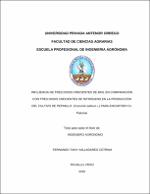Mostrar el registro sencillo del ítem
Influencia de tres dosis crecientes de biol en comparación con tres dosis crecientes de nitrógeno en la producción del cultivo de pepinillo (Cucumis sativus L.) para encurtido Cv. Palomar
| dc.contributor.advisor | Huanes Mariños, Milton Americo | |
| dc.contributor.author | Valladares Cotrina, Fernando Tany | |
| dc.creator | Valladares Cotrina, Fernando Tany | |
| dc.date.accessioned | 2017-03-22T16:02:45Z | |
| dc.date.available | 2017-03-22T16:02:45Z | |
| dc.date.issued | 2017 | |
| dc.identifier.uri | https://hdl.handle.net/20.500.12759/2426 | |
| dc.description.abstract | Esta investigación se realizó en el Campus UPAO II, ubicado en la prolongación de la avenida Villareal S/N – Nuevo Barraza, distrito de Laredo, provincia de Trujillo, región La Libertad, de febrero a marzo del 2016. El objetivo fue determinar la influencia de tres dosis crecientes de Biol (1, 2 y 3 m 3 Biol/ha) y tres dosis crecientes de nitrógeno (100, 150 y 200 kg/ha) utilizando como fuente la urea, en la producción del cultivo de pepinillo (Cucumis sativus L.) Cv. Palomar para encurtido. El diseño experimental fue de Bloques Completamente al Azar (BCA), con 7 tratamientos y 4 repeticiones, y se realizó un análisis de varianza y la prueba de significación de Duncan al 0.05 de probabilidad. Los parámetros evaluados fueron altura de planta, número de hojas por planta, diámetro de tallo por planta, número de flores por planta, acumulación de biomasa fresca por planta, acumulación de biomasa seca por planta, a los 20, 40 y 56 días después de la siembra. También durante la cosecha, se evaluaron número de frutos por planta (según categorías) y rendimiento por hectárea. Los resultados demostraron que el rendimiento total de pepinillo (Cucumis sativus L.) Cv. Palomar para encurtidos respondió satisfactoriamente a la dosis de 200 kg N/ha, con 8782.81 kg/ha superando al testigo (sin aplicación) en 38.4 %. El mayor rendimiento total en aplicación de Biol se obtuvo con la dosis de 3 m3 Biol/ha con 7431.50 kg/ha superando al testigo en 27.2 %. | es_PE |
| dc.description.abstract | This research was carried out in UPAO II Campus, located at Villarreal Avenue without number – New Barraza, district of Laredo, province of Trujillo, region La Libertad (Peru), from February to March 2016. The objective was to determine the influence of three increasing doses of Biol (1, 2 and 3 m 3 Biol/ha) and three increasing doses of nitrogen (100, 150 and 200 kg N/ha) on the yield of pickles (Cucumis sativus L.) Cv. Palomar. The experimental design was Randomized Complete Block, with 7 treatments and 4 replicates, and it was performed the variance analysis and Duncan significant test at 0.05 of probability. Plant Height, number of leaves per plant, stem diameter per plant, number of flowers per plant, accumulation fresh biomass per plant, and accumulation of dry biomass per plant were evaluated 20, 40, and 56 days after sowing. Number of fruits per plant (according to categories) and yield per hectare were also evaluated during harvesting. The results showed that the yield of pickles (Cucumis sativus L.) Cv. Palomar had satisfactory response to the dose of 200 kg N/ha, with 8782.81 kg/ha, over yielding the control (without application) in 38.4 %. The higher yield with Biol was obtained with the dose of 3 m3 Biol/ha with 7431.50 kg/ha up yielding control in 27.2 %. | en_US |
| dc.description.uri | Tesis | es_PE |
| dc.format | application/pdf | es_PE |
| dc.language.iso | spa | es_PE |
| dc.publisher | Universidad Privada Antenor Orrego | es_PE |
| dc.relation.ispartofseries | T_ING.AGRON_465 | |
| dc.rights | info:eu-repo/semantics/openAccess | es_PE |
| dc.rights.uri | https://creativecommons.org/licenses/by/4.0/ | es_PE |
| dc.source | Universidad Privada Antenor Orrego | es_PE |
| dc.source | Repositorio Institucional - UPAO | es_PE |
| dc.subject | Biol | es_PE |
| dc.subject | Nitrógeno | es_PE |
| dc.title | Influencia de tres dosis crecientes de biol en comparación con tres dosis crecientes de nitrógeno en la producción del cultivo de pepinillo (Cucumis sativus L.) para encurtido Cv. Palomar | es_PE |
| dc.type | info:eu-repo/semantics/bachelorThesis | es_PE |
| thesis.degree.level | Título Profesional | es_PE |
| thesis.degree.grantor | Universidad Privada Antenor Orrego. Facultad de Ciencias Agrarias | es_PE |
| thesis.degree.name | Ingeniero Agrónomo | es_PE |
| thesis.degree.discipline | Ingeniería Agrónoma | es_PE |
| dc.publisher.country | PE | es_PE |
Ficheros en el ítem
Este ítem aparece en la(s) siguiente(s) colección(es)
-
Ingeniería Agrónoma [93]


